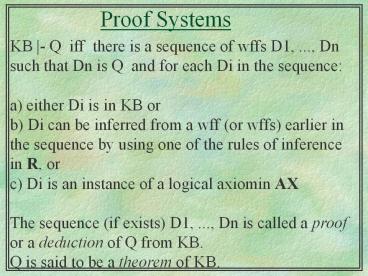Proof Systems PowerPoint PPT Presentation
Title: Proof Systems
1
Proof Systems
KB - Q iff there is a sequence of wffs D1,
..., Dn such that Dn is Q and for each Di in
the sequence a) either Di is in KB or b) Di can
be inferred from a wff (or wffs) earlier in the
sequence by using one of the rules of inference
in R, or c) Di is an instance of a logical
axiomin AX The sequence (if exists) D1, ..., Dn
is called a proof or a deduction of Q from KB. Q
is said to be a theorem of KB. KB - Q a) by
the definition of entailment
2
What is soundness?
- For every KB and Q, if KB - Q then KB Q
- Informally, a proof system is sound if it only
generates entailed wffs - (every positive answer is correct)
- (remember that the semantical system is the
reference) - A sound proof system is truth-preserving
- any model for the original set of wffs (KB) is
also a model for the derived set of wffs (Q).
3
Completeness
- One other question we can ask is whether using
our proof system we can generate all of the
entailed wffs - (the system can give all the correct answers)
- If we are able to do so, we say that our
inference procedure is complete - For every KB and Q, if KB Q then KB - Q
- Equivalent form if KB /- Q then KB /- Q
4
Complexity
- Truth-tables are exponential in the number of
atoms 2n interpretations - Cook 71 showed that Satisfiability is a
- NP-complete problem.
- But in many cases answers can be found very
quickly (Horn-Sat is solvable linear time) - in fact really hard problems are quite rare (see
hw).
5
Proof Systems
- Several proof systems in the literature
- Resolution (the only one we will study)
- SLD resolution - basis of PROLOG
- Tableaux
- Natural Deduction
- Sequent Calculus (Gentzen)
- Axiomatic (Hilbert)
6
Clauses as wffs
- More adequate for computation - canonical form
- A literal is either an atom (positive literal) or
the negation of an atom (negative literal). - A clause is a disjunction of literals the empty
clause is equivalent to False. - A wwf is in Conjunctive Normal Form (CNF) iff it
is a set of clauses (the set is abreviating the
conjunction of all the clauses).
7
Converting arbitrary wffs to CNF
- Eliminate implications
- A ? B becomes ?A ? B
- Move ? inwards
- Apply De Morgans
- ?(A v B) becomes (?A ? ?B)
- ?(A ? B) becomes (?A v ?B)
- Apply double negation rule
- ? ? A becomes A
8
Converting arbitrary wffs to CNF
- Distribute ? over v
- (A ? B) v C becomes (A v C) ? (B v C)
- Flatten nested conjunctions and disjunctions
- (A v B) v C becomes (A v B v C)
- (A ? B) ? C becomes (A ? B ? C)
- At this point we have a conjunction of clauses
- We must have a set of clauses!
- separate the conjuncts
9
Important Theorem
- Let S be a set of wffs and S the set of clauses
obtained by converting S to CNF. - In Propositional Logic S and S are equivalent
but in FOL they are not equivalent in general - But in both logics we have
- S is unsatisfiable iff S is unsatisfiable.
- Therefore, KB Q iff S KB U ? Qis unsat
- iff S is unsat
10
Resolution System
- Language Clauses
- Logical Axioms AX
- Inference Rules
- R Resolution
- Notice that since the language is clausal,
resolution is applied only to clauses - P1 v ... v Pi v ... v Pn , Q1 v ... v ? Pi v ...
v Qm - --------------------------------------------------
------- - P1v...vPi-1vPi1v...vPn vQ1v...vQj1vQj1v...vQm
- The conclusion is called the resolvent
11
Resolution System
- Soundness
- Since its only rule is resolution and there are
no logical axioms, it is easy to show that the
resolution system is sound - show the soundness of the resolution inference
rule - (show by truth-table that the premisses entail
the - conclusion)
- and then show by induction on the length of a
proof - that if S - False then S False.
12
Resolution System
- Completeness
- Resolution is not complete
- P , R P V R but P , R /- P V R
- But Resolution is Refutation Complete
- Let S CNF(KB U ? Q)
- If KB Q then S - False
- P , R, ? P, ? R - False
13
Resolution System
- To answer if KB Q
- Convert S KB U ? Q into S CNF(S)
- convert each formula of S into clauses
- Iteratively apply resolution to the clauses in S
and add the results to S either until there are
no more resolvents that can be added or until the
empty clause is produced.
14
Refinement Strategies
- The procedure described above is inefficient
because some resolutions need not be performed at
all (are irrelevant). - Refinement strategies disallows certain kinds of
resolutions to take place. - Linear resolution with initial set of support
15
Proof as a search task
- State representation
- a set of wffs (considered to to be true)
- Operators inference rules
- Start state an initial set of wffs
- (what is initially considered to to be true)
- Goal state the wff to prove is in our states
set of known wffs

